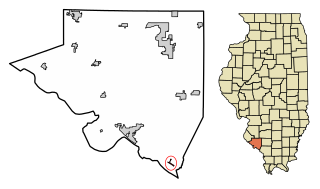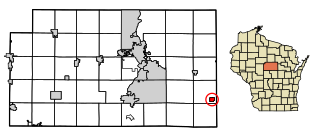
Panama is a village in Montgomery and Bond counties, Illinois, United States. The population was 337 at the 2020 census.

Aviston is a village in Clinton County, Illinois, United States. The population was 2,340 at the 2020 census, up from 1,945 at the 2010 census.

Damiansville is a village in Clinton County, Illinois, United States. The population was 564 at the 2020 census, up from 491 at the 2010 census.

Buckner is a village in Franklin County, Illinois, United States. The population was 409 at the 2020 census. The current mayor is Aaron Eubanks.

North City is a village in Franklin County, Illinois, United States. As of the 2020 census, the population was 509. North City is also known as "Coello". The current mayor is Curtis Overton.

Campbell Hill is a village in Jackson County, Illinois, United States. The population was 309 at the 2020 census.

Gorham is a village in Jackson County, Illinois, United States. The population was 236 at the 2010 census. It is known locally for its near-annihilation during the deadly Tri-State Tornado of 1925.

Hamel is a village in Madison County, Illinois, United States. The population was 929 at the 2020 census. It is a part of the Illinois Metro East portion of the Greater St. Louis metropolitan area.

Taylor Springs is a village in Montgomery County, Illinois, United States. The population was 690 at the 2010 census.

Walshville is a small village in Montgomery County, Illinois, United States. The population was 89 at the 2000 census.

Rockwood is a village in Randolph County, Illinois, United States. The population was 42 at the 2010 census. It is the headquarters of the Middle Mississippi River National Wildlife Refuge.

Buffalo is a village in Mechanicsburg Township in Sangamon County, Illinois, United States. The population was 503 at the 2010 census. It is part of the Springfield, Illinois Metropolitan Statistical Area.

German Valley is a village in Stephenson County, Illinois, United States. German Valley is located four miles south of U.S. Route 20 between Freeport and Rockford. German Valley had a population of 463 at the 2010 census, down from 481 in 2000.

North Pekin is a village in Tazewell County, Illinois, United States. The population was 1,573 at the 2010 census. North Pekin is a suburb of Peoria and is part of the Peoria, Illinois Metropolitan Statistical Area.

Alto Pass is a village in Union County, Illinois, United States. The population was 391 at the 2010 census, an increase from 388 in 2000. The Bald Knob Cross and Bald Knob Wilderness are nearby. Alto Pass lies roughly 5.1 miles to the northwest of downtown Cobden, Illinois.

Bush is a village in Williamson County, Illinois, United States. As of the 2000 census, the village population was 257.

Carterville is a city in Williamson County, Illinois, United States. At the 2020 census, the city's population was 5,848. The city is part of the Carbondale-Marion combined statistical area and has grown considerably as a residential community of Carbondale and Marion.

Crainville is a village in Williamson County, Illinois, United States. The population was 1,254 at the 2010 census.

Carterville is a city in Jasper County, Missouri, United States. The population was 1,855 at the 2020 census. It is part of the Joplin, Missouri Metropolitan Statistical Area.

Elderon is a village in Marathon County, Wisconsin, United States. It is part of the Wausau, Wisconsin Metropolitan Statistical Area. The population was 179 at the 2010 census.























